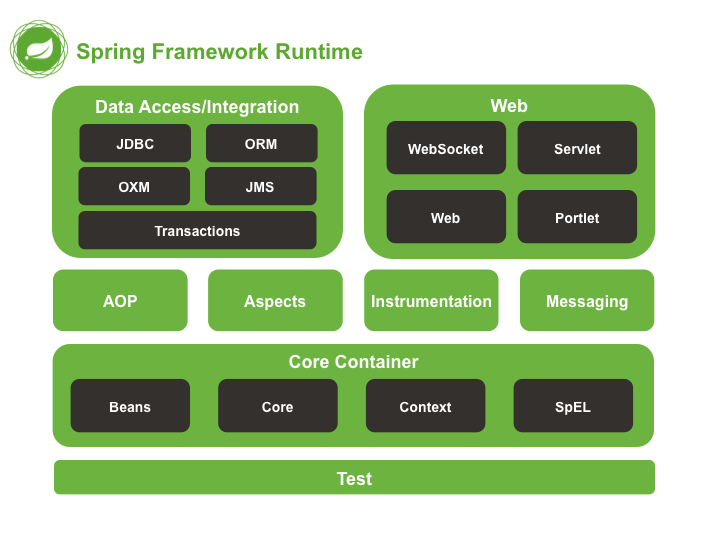Spring
Spring简介
Spring介绍
Spring是一个非常活跃的开源框架,它基于IOC和AOP来架构多层JavaEE系统,以帮助分离项目间组件的相互依赖关系。它的主要目的是简化企业开发。
Spring解决的问题
方便解耦,简化开发:可以把所有对象的创建和依赖关系维护交给Spring来管理。
AOP编程:Spring是面向切面编程的,可以方便的对应用程序进行权限拦截、运行监控。
声明式事务的支持:只需要配置好相关的配置文件就可以实现对事务的管理,不需要手动编程。
方便的程序测试:Spring对Junit4的支持,通过注解的方式方便的对Spring程序进行测试。
方便集成各种优秀的框架:Spring不排斥其他优秀的开源框架,期内部提供了对许多优秀的框架的直接支持。
降低了JavaEE API的使用难度:对JavaEE中一些难使用的API都进行了封装,降低了这些API的使用难度。
Spring的组成
Spring的功能大约由20个模块组成,这些模块按组可分为核心容器、数据访问/集成、Web、AOP、设备、消息、测试。
Spring的组成图
入门程序和IOC简介
依赖注入和反转控制的定义中,调用者不负责被调用者的实例创建的工作,该工作由Spring框架中的容器完成,它通过开发者的配置来确定实例类型,实例化对象后再注入调用者。
IOC控制反转
降低对象间的耦合关系的设计思想,开发者不再关注对象的创建,交给Spring来完成。
缺点:因为对象是通过反射的机制来完成创建的,对性能有一定的影响。
DI依赖注入
Denpendency Injection 说的是创建实例化对象时,同时为对象注入其依赖的属性。将bean与bean的关系交给容器管理,这个容器就是Spring。
IOC和DI
所谓依赖注入,说的是IOC容器在运行的过程中,动态的将某种依赖关系注入到对象中。
所以依赖注入(DI)和控制反转(IOC)是从两个不同的方向描述的同一件事,就是通过引入IOC,利用依赖注入的方式,实现对象间的解耦。
练习
导入jar包
通过配置pom.xml实现jar包的导入
<dependency>
<groupId>org.springframework</groupId>
<artifactId>spring-context</artifactId>
<version>4.2.8.Release</version>
</dependency>
<dependency>
<groupId>org.springframework</groupId>
<artifactId>spring-core</artifactId>
<version>4.2.8.RELEASE</version>
</dependency>
<dependency>
<groupId>org.springframework</groupId>
<artifactId>spring-beans</artifactId>
<version>4.2.8.RELEASE</version>
</dependency>
<dependency>
<groupId>org.springframework</groupId>
<artifactId>spring-context-support</artifactId>
<version>4.2.8.RELEASE</version>
</dependency>
<dependency>
<groupId>org.springframework</groupId>
<artifactId>spring-expression</artifactId>
<version>4.2.8.RELEASE</version>
</dependency>
<dependency>
<groupId>commons-logging</groupId>
<artifactId>commons-logging</artifactId>
<version>1.1.2</version>
</dependency>
<dependency>
<groupId>log4j</groupId>
<artifactId>log4j</artifactId>
<version>1.2.14</version>
</dependency>
创建操作类
package com.xiaoyao.spring.bean;
public class Person {
private String name;
private Integer age;
public Person() {
System.out.println("------------> Person.Person");
}
}
创建配置文件
<?xml version="1.0" encoding="UTF-8"?>
<beans xmlns="http://www.springframework.org/schema/beans"
xmlns:xsi="http://www.w3.org/2001/XMLSchema-instance"
xsi:schemaLocation="http://www.springframework.org/schema/beans http://www.springframework.org/schema/beans/spring-beans.xsd">
<!--
id 和 name 可以同时存在,作为bean的标识
class添加的应该是class的全路径
-->
<bean
id="personId" name="personName" class="com.itqf.spring.bean.Person"
/>
</beans>
测试用例
@Test
public void test1(){
//TODO 测试IOC
ApplicationContext applicationContext = new ClassPathXmlApplicationContext("applicationContext.xml");
//getBean 可以使用配置文件中的id值,也可以使用配置文件的name值.
Person person = (Person) applicationContext.getBean("personId");
System.out.println("person = " + person);
}
对象创建的细节
bean标签属性
| Property | 属性解释 |
|---|---|
| class | 指定bean对应类的全路径 |
| name | name是bean对应对象的一个标识 |
| scope | 执行bean对象创建模式和生命周期 |
| id | id是bean对象的唯一标识,不能添加特别字符 |
| lazy-init | 是否延时加载 默认值:false |
| init-method | 对象初始化方法 |
| destory | 对象销毁方法 |
创建对象工厂
public void test() {
ApplicationContext ctx = new ClassPathXmlApplicationContext("applicationContext.xml");
}
bean标签
id和name的作用几乎相同,但是还是有细微的差别,id不允许重复,不允许使用特殊的字符。
<!--同时添加name和id --> <bean name="testBeanName" id="testBeanId" class="com.xiaoyao.spring.bean.TestBean" />
获取bean
ApplicationContext applicationContext = new ClassPathXmlApplicationContext("applicationContext-bean.xml");
/**
* 参数1: name/id
* 参数2(可选): 可以指定生成对象类型,如果不填此参数,需进行强转
* 两种方式都可以获取!
*/
TestBean testBeanName = applicationContext.getBean("testBeanName", TestBean.class);
TestBean testBeanId = applicationContext.getBean("testBeanId", TestBean.class);
Scope属性
用于设置bean对应对象的实例化规则,可以设置为:singleton和prototype
singleton为默认值,默认在Spring容器启动时,实例化bean对应的对象。只会实例化一次,后面使用的对象为同一个对象。
<bean name="testBeanName" scope="singleton" id="testBeanId" class="com.itqf.spring.bean.TestBean" />
prototype在调用getBean时实例化bean对应的对象。每次getBean时都会实例化一个对象,每个对象不相同。
<bean name="testBeanName" scope="prototype" id="testBeanId" class="com.itqf.spring.bean.TestBean" />lazy-init属性(是否延时初始化)
只对Scope设置为Singleton时有效。
lazy-init设置为true时,scope=singleton,延时初始化bean对应的对象。
<bean name="testBeanName" id="testBeanId" scope="singleton" lazy-init="true" class="com.itqf.spring.bean.TestBean" />
lazy-init设置为false时,scope=singleton,不延时初始化bean对应的对象,在Spring容器启动时初始化。
<bean name="testBeanName" id="testBeanId" scope="singleton" lazy-init="false" class="com.itqf.spring.bean.TestBean" />
对象创建的几种方式
静态工厂
<bean name="personFactory" class="com.itqf.spring.utils.PersonFactory" factory-method="createPerson" />
非静态工厂
<bean name="personFactory1" class="com.itqf.spring.utils.PersonFactory" /> <bean name="personFactory2" factory-bean="personFactory1" factory-method="createPerson1" />
